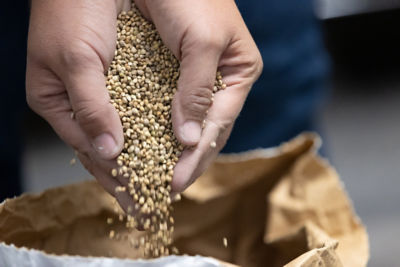Whether or not a rootstock has resistance to ToBRFV is unlikely to make a difference in the occurrence of symptoms. The resistance in the scion is decisive when it comes to the question of whether symptoms will be visible. This is evident from research carried out on behalf of Bayer's vegetable seed division in the Netherlands.
The research confirms how important rootstocks are. "The strength and endurance of the rootstock provide a safe basis for the best production, even if the rootstock is not resistant to ToBRFV," says Jan Kamper, Global Protected Segment Market Development Lead at Bayer.
Tomato rootstocks are the basis of a highly productive crop. Good roots provide good water and nutrition uptake, especially under harsh conditions.
Uptake of ToBRFV by roots
In general, virus infection starts with a mechanical infection when workers are handling the head of the plant. The virus moves quickly to the head of the plant, which is the most active growing part, but also to the roots through the phloem.
In some cases, ToBRFV might infect the plant from drain water and/or substrate. To investigate this issue, Bayer conducted an experiment at an independent institute, Groen Agro Control, to investigate how easily roots can be infected.
In the trial, young plants were grown until roots emerged from the underside of the normal rockwool planting block. These roots were then damaged, and then a solution containing ToBRFV was applied to infect the roots. After six weeks, the roots and the above-ground plants were tested for ToBRFV.
"Bayer: growing power and endurance in rootstock are important weapons against ToBRFV."
The results showed that the roots in the middle of the rockwool block (i.e., not the roots that were initially infected) showed very low levels of ToBRFV. The PCR values were around 32 - indicating the presence of virus particles. However, in terms of biological relevance, it is insufficient to identify a genuine ToBRFV infection in the plant. In the leaves of the scion, no virus was detected at all, indicating that ToBRFV was not transported from the roots to the shoots of the scion.
Rootstock | Scion | Inoculation with: | Presence ToBRFV in | Presence of ToBRFV in |
Susceptible | Susceptible | Water | Not detected | Not detectable |
Susceptible | Susceptible | ToBRFV | Ct value = 32 | Not detectable |
Resistant | Susceptible | Water | Not detected | Not detectable |
Resistant | Susceptible | ToBRFV | Ct value = 34 | Not detectable |
This result, which suggests little or no uptake of the virus from the roots, is in line with other research*.
Rootstock influence on scion appearance and ToBRFV levels
There is little information about ToBRFV in the roots of tomato plants. Also, the effect of the rootstock in relation to the scion and ToBRFV levels has not yet been investigated, so Bayer also conducted a trial to investigate this topic.
The trial was set up as follows. A resistant variety and a susceptible variety were each grafted onto a susceptible rootstock and a resistant rootstock. The scions were inoculated first with Pepino Mosaic Virus and a week later with ToBRFV.
Twelve days after inoculation, the ToBRFV concentration in the scion was measured. It resulted that the susceptible scion, showed a similar concentration of ToBRFV whether it was grafted to a susceptible or a resistant rootstock,. The virus concentration in scion was already high, and soon after, the first symptoms were visible.
The resistant scions resisted the ToBRFV longer, but there was no influence from the rootstock, whether resistant or susceptible.
After 35-40 days, the susceptible scions showed severe leaf and fruit symptoms, and the resistant scions showed some symptoms after 50 days. The experiment ended after 3.5 months, and the final examination showed hardly any leaf symptoms and no fruit symptoms in the resistant varieties, whether grafted on susceptible or resistant rootstocks.
More research needed
The experiment was carried out in early spring in the Netherlands, so light conditions were low, representing a difficult period of the year for tomato cultivation. As such, more experiments and research are needed.
Importantly, these test results confirm the value of a strong rootstock as a base for good production. A good rootstock offers advantages during the entire cycle. And strong rootstock with endurance and a good root system can support stronger plant development, which may lead to less severe infections throughout the season.
Many growers and plant raisers tell us they prefer a strong rootstock with endurance. A new and less strong rootstock is seen as a higher risk for good production. So, even if the rootstock is not resistant to ToBRFV, the power and strength of the rootstock is a secure base for the best production.



